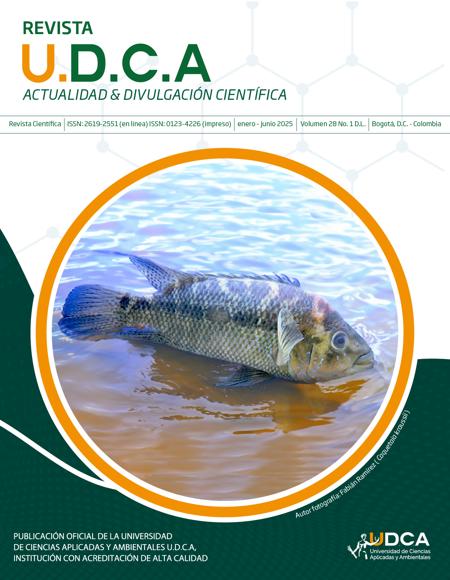Cuantificación y caracterización de bacterias nitrificantes aisladas de un sistema acuapónico
Quantification and characterization of nitrifying bacteria isolated from an aquaponic system
Contenido principal del artículo
Resumen
Las bacterias nitrificantes son esenciales en los sistemas acuapónicos porque transforman los desechos nitrogenados en nutrientes útiles para las plantas, evitando la toxicidad por amonio en los peces. Este estudio buscó cuantificar y caracterizar las bacterias nitrificantes cultivables en un sistema acuapónico a lo largo del tiempo, utilizando dos sistemas replicados con la planta berro (Nasturtium officinale), y los peces tilapia del Nilo (Oreochromis niloticus), tilapia roja (Oreochromis sp.) y cachama blanca (Piaractus orinoquensis). Se tomaron muestras en tres momentos (0, 3 y 6 meses) del tanque de peces, hidrociclón y biofiltro. La mayor abundancia bacteriana se detectó en los tanques de peces, probablemente debido a mayores niveles de oxígeno y disponibilidad de nutrientes, observándose un incremento a lo largo del tiempo. El análisis de correlación indicó que ciertos nutrientes como potasio, fosfato, manganeso y nitrato podrían favorecer la proliferación de bacterias nitrificantes. Se aislaron y caracterizaron fenotípicamente nueve morfotipos bacterianos, la mayoría de los cuales presentó tinción Gram positiva e hidrólisis de urea negativa. Se proporciona información sobre la dinámica espaciotemporal de las bacterias nitrificantes en sistemas acuapónicos, destacando su papel en el reciclaje de nutrientes. La elevada abundancia bacteriana registrada resalta el potencial del sistema para la reutilización eficiente de nutrientes. Se recomienda aplicar técnicas moleculares, como la secuenciación del gen 16S rRNA y el análisis metagenómico, para identificar los morfotipos y entender mejor la comunidad microbiana. Estos hallazgos refuerzan la importancia de las bacterias nitrificantes en el rendimiento del sistema y el avance de prácticas agrícolas sostenibles.
Palabras clave:
Descargas
Datos de publicación
Perfil evaluadores/as N/D
Declaraciones de autoría
- Sociedad académica
- Universidad de Ciencias Aplicadas UDCA
- Editorial
- Universidad de Ciencias Aplicadas y Ambientales U.D.C.A
Detalles del artículo
Referencias (VER)
AGUIRRE, J.P.; TORRES-MESA, A.; PÉREZ-TRUJILLO, M.M.; RUBIO-CASTRO, S.A.; GÓMEZ-RAMÍREZ, E. 2023. Evaluation of Fragaria x ananassa in an aquaponic system with Oncorhynchus mykiss and substrate culture conditions. AACL Bioflux. 16(5):2589-2600.
AMERICAN PUBLIC HEALTH ASSOCIATION – APHA. 2017. Standard methods for the examination of water and wastewater. Volume 3. Andesite Press. 138p.
BARTELME, R.P.; OYSERMAN, B.O.; BLOM, J.E.; SEPULVEDA-VILLET, O.J.; NEWTON, R.J. 2018. Stripping away the soil: plant growth promoting microbiology opportunities in aquaponics. Frontiers in Microbiology. 9:8. https://doi.org/10.3389/fmicb.2018.00008
BARTELME, R.P.; SMITH, M.C.; SEPULVEDA-VILLET, O.J.; NEWTON, R.J. 2019. Component microenvironments and system biogeography structure microorganism distributions in recirculating aquaculture and aquaponic systems. mSphere. 3(4):143-19. https://doi.org/10.1128/mSphereDirect.00019-19
BIROLO, M.; BORDIGNON, F.; TROCINO, A.; FASOLATO, L.; PASCUAL, A.; GODOY, S.; NICOLETTI, C.; MAUCIERI, C.; XICCATO, G. 2020. Effects of stocking density on the growth and flesh quality of rainbow trout (Oncorhynchus mykiss) reared in a low-tech aquaponic system. Aquaculture. 529:735653. https://doi.org/10.1016/j.aquaculture.2020.735653
BRITTO, D.T.; KRONZUCKER, H.J. 2013. Ecological significance and complexity of N-source preference in plants. Annals of Botany. 112(6):957-963. https://doi.org/10.1093/aob/mct157
CANFIELD, D.E.; GLAZER, A.N.; FALKOWSKI, P.G. 2010. The evolution and future of earth's nitrogen cycle. Science. 84(330):192-196. https://doi.org/10.1126/science.1186120
CARRASQUERO FERRER, S.J.; PIRE SIERRA, M.C.; COLINA ANDRADE, G.; MAS Y RUBÍ, M.; MARTÍNEZ, D.; DÍAZ MONTIEL, A. 2014. Tasas de nitrificación y desnitrificación durante el tratamiento biológico de efluentes de tenerías en un reactor por carga secuencial. Boletín del Centro de Investigaciones Biológicas. 47(3):220-234.
CASTELLANOS-ROZO, J.; RAMOS-PARRA, Y.J. 2015. Caracterización de bacterias oxidadoras de amonio aisladas del humedal de la planta de tratamiento de aguas residuales de la Universidad de Boyacá. I3+. 2(1):82-95. https://doi.org/10.24267/23462329.78
CASTRO-GONZÁLEZ, M.; MOLINA-TRINCADO, V.; GÓMEZ-RAMÍREZ, E.; NARANJO-ROBAYO, N. 2023. Nitrous oxide production and microbial diversity in an aquaponic system. AACL Bioflux. 16(6):3032-3047.
CAYCEDO LOZANO, L.; CORRALES RAMÍREZ, L.C.; TRUJILLO SUÁREZ, D.M. 2021. Las bacterias, su nutrición y crecimiento: una mirada desde la química. Nova. 19(36):49-94. https://doi.org/10.22490/24629448.5293.
CHANDRAPATI, S.; WILLIAMS, M.G. 2014. Total viable counts | Most Probable Number (MPN). In: Batt, C.A.; Tortorello, M.L. (Eds.). Encyclopedia of Food Microbiology. Second Edition. Academic Press. p. 621-624. https://doi.org/10.1016/B978-0-12-384730-0.00333-5
CHAUHAN, A.; JINDAL, T. 2020. Biochemical and molecular methods for bacterial identification. In: Chauhan, A.; Jindal, T. Microbiological methods for environment, food and pharmaceutical analysis. Springer. p. 425-468. https://doi.org/10.1007/978-3-030-52024-3_10
FARGES, B.; POUGHON, L.; RORIZ, D.; CREULY, C.; DUSSAP, C.G.; LASSEUR, C. 2012. Axenic cultures of Nitrosomonas europaea and Nitrobacter winogradskyi in autotrophic conditions: a new protocol for kinetic studies. Applied Biochemistry and Biotechnology. 167(5):1076-1091. https://doi.org/10.1007/s12010-012-9651-6
FERNÁNDEZ, A.; GARCIA DE LA FUENTE, C.; SAEZ, J.; VALDEZATE, S. 2010. Métodos de identificación bacteriana en el laboratorio de microbiología. Seimc. 9(1):1-28.
FRENCH, E.; KOZLOWSKI, J.A.; MUKHERJEE, M.; BULLERJAHN, G.; BOLLMANN, A. 2012. Ecophysiological characterization of ammonia-oxidizing archaea and bacteria from freshwater. Applied and Environmental Microbiology. 78(16):5773-5780. https://doi.org/10.1128/AEM.00432-12
GODDEK, S.; ESPINAL, C.A.; DELAIDE, B.; JIJAKLI, M.H.; SCHMAUTZ, Z.; WUERTZ, S.; KEESMAN, K.J. 2016. Navigating towards decoupled aquaponic systems: A system dynamics design approach. Water. 8:303. https://doi.org/10.3390/w8070303
GYAMFI, S.; EDZIYIE, R.E.; OBIRIKORANG, K.A.; ADJEI-BOATENG, D.; SKOV, P.V. 2024. Nile tilapia (Oreochromis niloticus) show high tolerance to acute ammonia exposure but lose metabolic scope during prolonged exposure at low concentration. Aquatic Toxicology. 271:106932. https://doi.org/10.1016/j.aquatox.2024.106932
HERNÁNDEZ, E.; AGUIRRE, N.; PALACIO, J.; RAMÍREZ, J.J.; DUQUE, S.R.; GUISANDE, C.; ARANGUREN, N.; MOGOLLÓN, M. 2013. Evaluación comparativa de algunas características limnológicas de seis ambientes leníticos de Colombia. Revista Facultad de Ingeniería Universidad de Antioquia. 69:216-228. https://doi.org/10.17533/udea.redin.18151
KIM, B.H.; GADD, G.M. 2008. Bacterial physiology and metabolism. Cambridge University Press. United Kingdom. 512p. https://doi.org/10.1017/CBO9780511790461
KOOPS, H.P.; PURKHOLD, U.; POMMERENING-RÖSER, A.; TIMMERMANN, G.; WAGNER, M. 2006. The Lithoautotrophic Ammonia-Oxidizing Bacteria. In: Dworkin, M.; Falkow, S.; Rosenberg, E.; Schleifer, K.H.; Stackebrandt, E. (eds). The Prokaryotes: A Handbook on the Biology of Bacteria. 3rd ed., Volume 5, Proteobacteria: Alpha and Beta Subclasses. Springer. Germany. p.778-812.
KOUKI, S.; SAIDI, N.; M’HIRI, F.; NASR, H.; CHERIF, H.; OUZARI, H.; HASSEN, A. 2011. Isolation and characterization of facultative mixotrophic ammonia-oxidizing bacteria from constructed wetlands. Journal of Environmental Sciences. 23(10):1699-1708.
LAL, J.; VAISHNAV, A.; DEB, S.; KASHYAP, S.; DEBBARMA, P.; DEVATI; GAUTAM, P.; PAVANKALYAN, M.; KUMARI, K.; VERMA, D.K. 2024. Re-circulatory aquaculture systems: A pathway to sustainable fish farming. Archives of Current Research International. 24(5):799-810. https://doi.org/10.9734/acri/2024/v24i5756
LEES, H.; QUASTEL, J.H. 1945. Bacteriostatic effects of potassium chlorate on soil nitrification. Nature. 155(3931):276-278. https://doi.org/10.1038/155276A0
LI, P.; TONG, L.; LIU, K.; WANG, Y.; WANG, Y. 2009. Indole degrading of ammonia oxidizing bacteria isolated from swine wastewater treatment system. Water Science & Technology. 59(12):2405-2410. https://doi.org/10.2166/wst.2009.312
LOVE, D.C.; FRY, J.P.; GENELLO, L.; HILL, E.S.; FREDERICK, J.A.; LI, X.; SEMMENS, K. 2014. An international survey of aquaponics practitioners. PLoS One. 9:1-10. https://doi.org/10.1371/journal.pone.0113883
LOVE, D.C.; UHL, M.S.; GENELLO, L. 2015. Energy and water use of a small-scale raft aquaponics system in Baltimore, Maryland, United States. Aquac. Eng. 68:19-27. https://doi.org/10.1016/j.aquaeng.2015.02.002
MAIER, R. 2000. Biogeochemical cycling. In: Maier, R.; Pepper, I.; Gerba, C. (eds). Environmental Microbiology. Academic Press. San Diego, USA. 585p.
MASMELA-MENDOZA, J.E.; LIZARAZO-FORERO, L.M.; ARANGUREN RIAÑO, N.J. 2019. Bacterias nitrificantes cultivables de la zona limnética del lago de Tota, Boyacá. Revista U.D.C.A Actualidad & Divulgación Científica. 22(2):1378. https://doi.org/10.31910/rudca.v22.n2.2019.1378
MEHRANI, M.J.; SOBOTKA, D.; KOWAL, P.; CIESIELSKI, S.; MAKINIA, J. 2020. The occurrence and role of Nitrospira in nitrogen removal systems. Bioresource Technology. 3:13-21.
MUNGUIA-FRAGOZO, P.; ALATORRE-JACOME, O.; RICO-GARCIA, E.; TORRES-PACHECO, I.; CRUZ-HERNANDEZ, A.; OCAMPO-VELAZQUEZ, R.V.; GARCIA-TREJO, J.F.; GUEVARA-GONZALEZ, R.G. 2015. Perspective for Aquaponic Systems: “Omic” Technologies for Microbial Community Analysis. BioMed Research International. 2015:480386. https://doi.org/10.1155/2015/480386
NISHIO, T.; SHINYA, M.; FUJIWARA, Y.; YOSHIKURA, T.; FUKUYAMA, J. 2008. Phosphate deficiency and its effect on nitrification in the pond of a sea-based solid waste disposal site. Japanese Journal of Water Treatment Biology. 44(3):139-148. https://doi.org/10.2521/JSWTB.44.139
NISHIO, T.; SHINYA, Y.; YOSHIKURA, T.; FUKUYAMA, J. 2002. Effects of phosphate on nitrifying activity in a water treatment plant at low temperature. Japanese Journal of Water Treatment Biology. 38(1):21-28. https://doi.org/10.2521/JSWTB.38.21
OLIVER, A.; LILLEY, A.K.; VAN DER GAST, C.J. 2012. Species-time relationships for bacteria. In: Franklin, R.; Mills, A. (eds). Microbial Ecological Theory: Current Perspectives. ASM Press. Washington, DC, USA. p.71-86.
OWEN, A.; JONES, D. 2001. Competition for acids between wheat roots and rhizosphere microorganisms and the role of amino acids in plant N acquisition. Soil Biology and Biochemistry. 33(4-5):651-657. https://doi.org/10.1016/S0038-0717(00)00235-4
PAPP, B.; TÖRÖK, T.; SÁNDOR, E.; FEKETE, E.; FLIPPHI, M.; KARAFFA, L. 2016. High cell density cultivation of the chemolithoautotrophic bacterium Nitrosomonas europaea. Folia Microbiologica. 61(3):191-198. https://doi.org/10.1007/s12223-015-0425-8
PROSSER, J.I. 1990. Autotrophic nitrification in bacteria. Advances in Microbial Physiology. 30:125-181. https://doi.org/10.1016/S0065-2911(08)60112-5
RAMÍREZ SÁNCHEZ, L.M.; PÉREZ TRUJILLO, M.M.; JIMÉNEZ, P.; HURTADO GIRALDO, H.; GÓMEZ RAMÍREZ, E. 2011. Evaluación preliminar de sistemas acuapónicos e hidropónicos en cama flotante para el cultivo de orégano (Origanum vulgare: Lamiaceae). Revista Facultad de Ciencias Básicas. 7(2):242-259.
SCHMAUTZ, Z.; ESPINAL, C.A.; BOHNY, A.M.; REZZONICO, F.; JUNGE, R.; FROSSARD, E.; SMITS, T.H. 2021. Environmental parameters and microbial community profiles as indication towards microbial activities and diversity in aquaponic system compartments. BMC Microbiology. 21:12. https://doi.org/10.1186/s12866-021-02027-2
SOMERVILLE, C.; COHEN, M.; PANTANELLA, E.; STANKUS, A.; LOVATELLI, A. 2014. Small-scale aquaponic food production. Integrated fish and plant farming; FAO Fisheries and Aquaculture Technical Paper. Food and Agriculture Organization of the United Nations. Rome, Italy. 589p.
SUJITH, P.P.; BHARATHI, P.A. 2011. Manganese oxidation by bacteria: biogeochemical aspects. In: Müller, W. (eds). Molecular Biomineralization. Progress in Molecular and Subcellular Biology. Volume 52. Springer. Berlin, Heidelberg. p.49-76. https://doi.org/10.1007/978-3-642-21230-7_3
TORRES-MESA, A.; CIFUENTES-TORRES, L.; HURTADO-GIRALDO, H.; GOMÉZ-RAMIREZ, E. 2023. Evaluation of plant-fish ratio in an aquaponic system with different stocking densities of Cyprinus carpio and Carassius auratus. AACL Bioflux. 16(1):606-615.
UNDERHILL, S.E.; PROSSER, J.I. 1985. Inhibition of nitrification by potassium ethyl xanthate in soil and in liquid culture. Soil Biology and Biochemistry. 17(2):229-233. https://doi.org/10.1016/0038-0717(85)90119-1
VADIVELU, V.M.; KELLER, J.; YUAN, Z. 2007. Effect of free ammonia on the respiration and growth processes of an enriched Nitrosomonas culture. Water Research. 41(4):826-834. https://doi.org/10.1016/j.watres.2006.11.030
VERHAGEN, M.; LAANBROCK, J. 1991. Competition for limiting amounts of ammonium between nitrifying and heterotrophic bacteria in dual energy-limited chemostats. Applied and Environmental Microbiology. 57:3255-3263. https://doi.org/10.1128/AEM.57.11.3255-3263.1991
WELCH, L.F.; SCOTT, A.D. 1959. Nitrification in nutrient solutions with low levels of potassium. Canandian Journal of Microbiology. 5(5):425-430. https://doi.org/10.1139/M59-053
WONGKIEW, S.; POPP, B.N.; KHANAL, S.K. 2018. Nitrogen recovery and nitrous oxide (N2O) emissions from aquaponic systems: influence of plant species and dissolved oxygen. International Biodeterioration & Biodegradation. 134:117-126. https://doi.org/10.1016/j.ibiod.2018.08.008
WONGKIEW, S.; POPP, B.N.; KIM, H.; KHANAL, S.K. 2017. Fate of nitrogen in floating-raft aquaponic systems using natural abundance nitrogen isotopic compositions. International Biodeterioration & Biodegradation. 125:24-32. https://doi.org/10.1016/j.ibiod.2017.08.020
YOUSUF, S.; KARLINSEY, J.E.; NEVILLE, S.L.; MCDEVITT, C.A.; LIBBY, S.J.; FANG, F.C.; FRAWLEY, E.R. 2020. Manganese import protects Salmonella enterica serovar Typhimurium against nitrosative stress. Metallomics (United Kingdom). 12(11):1791-1801. https://doi.org/10.1039/d0mt00178c
ZERFAß, C.; CHRISTIE-OLEZA, J.A.; SOYER, O.S. 2018. Manganese oxide biomineralization is a social trait protecting against nitrite toxicity. BioRxiv 294975. 85(92).26. https://doi.org/10.1128/AEM.02129-18







